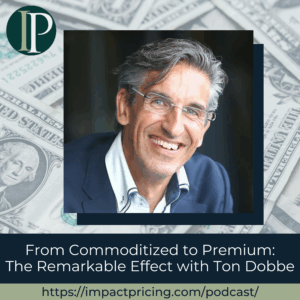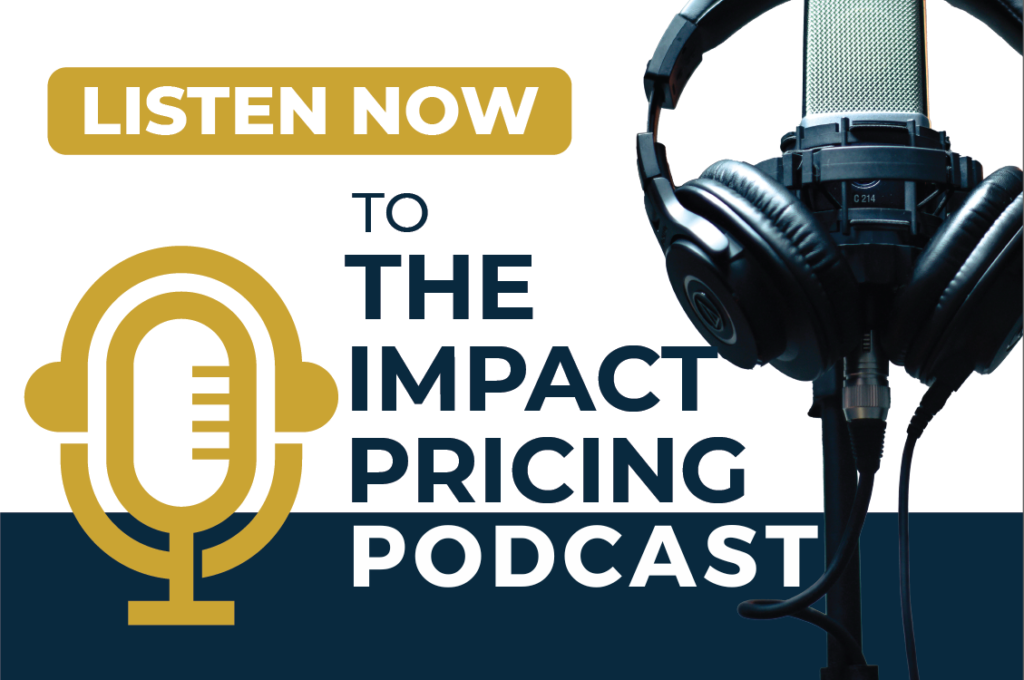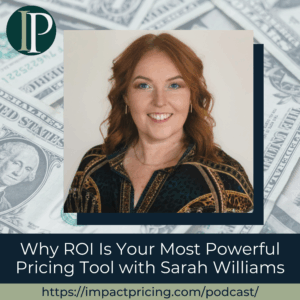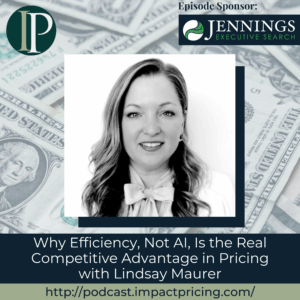Ton Dobbe is the founder of Value Inspiration, helping SaaS companies transform from commoditized to remarkable. He’s the author of The Remarkable Effect, where he explores what makes products stand out and command premium prices. And he’s a keynote speaker and podcast host himself.
In this episode, Ton shares his insights on how SaaS companies can escape the commodity trap and command premium pricing by focusing on their unique approach to solving customer problems, rather than just features and functions.
Podcast: Play in new window | Download
Why you have to check out today’s podcast:
- Learn how to identify and articulate the real problems your customers face that keep them awake at night.
- Discover why competing on your approach rather than features is the key to premium pricing.
- Understand how guarantees and risk reduction can justify higher prices and improve your entire business operation.
“Start thinking about what you do and why customers would pay a premium for that. And if you cannot answer that, there’s work to do. It’s a very simple question. What would it take for people to start paying a premium for it?”
– Ton Dobbe
Topics Covered:
02:37 – Startup failure and value proposition: Why 75% of software scalers fail despite achieving product-market fit and how the inability to market at appropriate value becomes their downfall
04:07 – Value is a story: Ton’s definition of value as “a story in the head of a customer” versus Mark’s “result of solving problems” and how perception drives pricing acceptance
09:28 – Value pricing and guarantees: How adding guarantees reduces customer fear of making mistakes and enables premium pricing, plus the psychology behind buyer decision-making
12:33 – Guaranteeing results for customers: The insurance model approach to guarantees and how implementation success creates win-win scenarios for both vendor and customer 15:28 – Competing on approach, not features: Why software companies must differentiate based on their unique approach to solving problems rather than feature comparisons with competitors
19:09 – Secret sauce for ideal customers: Ton’s 12-step “pressure cooker” process for identifying your value foundation and connecting company knowledge to customer segments
22:11 – Ideal customer segmentation benefits: How focusing on perfect-fit customers accelerates sales cycles, increases win rates, stops discounting, and improves every business function
27:59 – The value of AI solutions: Why companies fail when they position themselves as “AI-powered” instead of focusing on the specific problems their AI capabilities solve
30:39 – Premium pricing strategies: The fundamental question every company must answer – why would customers pay a premium for what you do, and what would it take to achieve that?
Key Takeaways:
“Value is a story in the head of a customer. When I say to you, for example, this is 30,000 US dollars. Some people will say, that’s expensive. And other people will say, that’s a bargain. And the difference is how well you communicate the value in a way that clicks with them.” – Ton Dobbe
“The moment you can add something like a guarantee or like a reliable promise to that, you can even charge more on pricing because it takes a lot of objections away around the fear of messing up.” – Ton Dobbe
“If you compete on a feature function level, everybody will lose. So you have to make a choice, are we going to compete on the feature function level or are we going to compete on something else?” – Ton Dobbe
“The moment you get that idea in their head, this is the choice and they’re gonna solve my problem better than anyone else. They’re gonna give me more value than anyone else. Well, why should I even start talking about discounts?” – Ton Dobbe
Resources and People Mentioned:
- The Jolt Effect (book on buyer indecision)
- Christian Owens, CEO of Paddle
Connect with Ton Dobbe:
- Website: https://valueinspiration.com
- Book: https://theremarkableeffect.com
- LinkedIn: https://www.linkedin.com/in/tondobbe/
Connect with Mark Stiving:
- LinkedIn: https://www.linkedin.com/in/stiving/
- Email: [email protected]
Full Interview Transcript
(Note: This transcript was created with an AI transcription service. Please forgive any transcription or grammatical errors. We probably sounded better in real life.)
Ton Dobbe
Start thinking about what you do and why customers would pay a premium for that. And if you cannot answer that, there’s work to do. It’s a very simple question. What would it take for people to start paying a premium for it?
[Intro / Ad]
Mark Stiving
Welcome to Impact Pricing, the podcast where we discuss pricing, value, and the remarkable relationship between them. I’m Mark Stiving, and I run boot camps to help companies get paid more. Our guest today is Ton Dobbe. Here are three things you want to know about Ton before we start. He’s the founder of Value Inspiration, helping SaaS companies transform from commoditized to remarkable. He’s the author of The Remarkable Effect, where he explores what makes products stand out and command premium prices. And he’s a keynote speaker and podcast host himself. Welcome, Ton.
Ton Dobbe
It’s a pleasure to be here, Mark. You pronounced my name pretty well.
Mark Stiving
Thank you. We were sitting here practicing it before we hit record.
Ton Dobbe
I’m Dutch, it’s hard.
Mark Stiving
So I always start with the question, how did you get into pricing? And you’re kind of into pricing the way I think of it, but how did you get into value? How did you get into this whole topic?
Ton Dobbe
Oh my God, that’s a story. Well, a little bit about my background. I have worked my entire career in the enterprise resource planning space. I worked for a software company called Unit 4. And pretty early in my career, I started in sales, then went to marketing, and then started doing product marketing. And pretty early in my career there, I also got to own pricing. First for the S&B market, and later on when we acquired a company in Norway. I became globally responsible for product marketing and product strategy. And pricing was sort of always in my pocket. So that’s where I got the other connection to pricing.
The value part is because of what my own passion is. It’s also why I wrote my book, The Remarkable Effect. I believe that there’s so many software companies out there. Well, I mean, when I left unit four and decided, what am I going to do next? I didn’t want to work for another large corporate anymore. And what I found was that a lot of startups fail. Some of the statistics are nine out of 10, some say 99 out of a hundred. And I was like, why? And I believe that a lot of these companies don’t have to fail if they do a couple of things right.
What made me even more crunch or be surprised is that 75% of scalers fail, which is another thing, you know, they have product market fit. They’ve come a long way. They have a lot of customers paying and still they fail. And at the end, it all boils down to an inability to market their products at an appropriate value. So that’s where value comes in, where pricing comes in, where value proposition comes in, where positioning comes in. Because if you fail there, the company, no matter how good it is, it will fail.
Mark Stiving
Okay, so we’re going to define value. I love talking about what’s the definition of value and I’ll compare yours to mine and all that. But before we jump there, I just want to share, I was a salesperson early in my career. I was an engineer first. And then I became a technical salesperson and I was horrible. Oh my gosh.
And as I look back, I know it’s because I used to talk about the product all the time. And I didn’t really talk about the customer and where the value was. And then I take that and I say, well, as I work with marketing people and I look at all of the webpages that are out there, everybody’s talking about their product. And so that leads us into, well, what’s value? Because the product isn’t value. The product delivers value, but it isn’t value. What do you think value is?
Ton Dobbe
Value is a story in the head of a customer. So when I say to you, for example, this is 30,000 US dollars, some people will say, that’s expensive. And other people will say, that’s a bargain. And the difference is how well you communicate the value in a way that clicks with them. That’s how simple it is at the end.
Mark Stiving
So although I don’t disagree with what you just said, I don’t find it helpful. I don’t find it useful. So essentially, if I were to try to use what you just said, I would say, well, now my job is to go make you believe a story. And I don’t know how to do that or what to do. Can I share my definition for a second?
Ton Dobbe
Yeah, sure.
Mark Stiving
So I define value as the result of solving problems. Yeah, true. Right. And so it’s perfectly consistent with yours, right? It’s the story that I’m telling myself, what are the problems I think I have? What are the results I think I’m going to achieve? Exactly.
Ton Dobbe
Yeah. And that’s exactly also what you said earlier. If you only talk about the product, you don’t make the connection to the problem that you solve. You let the customer connect the dots. And very often they cannot. If you show them all your features for one hour long and how impressive that is, they cannot connect how these features are going to solve their problem.
So actually, funny enough, just before this call, I did a one and a half hour workshop getting one of my customers’ salespeople from level zero to level four confidence when it comes to explaining the value of their products. And this session was about defining the problem. The funny thing is, even though people think that they understand, they’ve, for example, been in sales for 10 years, and a couple of people were, I asked them, okay, so what do you think is the problem that your customers typically have when they come to you? And they wrote down the things that they typically hear. And factually, it was all correct, but it wasn’t hitting a nerve.
So they were saying things like, they weren’t efficient enough. That’s the problem. They didn’t have enough transparency. They didn’t have enough visibility to make decisions. They weren’t in control of the business. So yes, technically at a very high level, that is a problem, but it’s more the, how do you say that? It’s the cause of a larger problem. The fact that you’re inefficient doesn’t mean anything. I mean, I always say, so what? The moment you start asking the so what question, people start explaining it and say, okay, well, the inefficiency is, and they give an example, of something that is the real thing.
And what I always try to get to is what are either the things that either wakes them up at night, every night, or what gets them fired. And for myself, I’ve written a long blog on it as well. It’s sort of a formula, this inability to either deliver on a commitment that you made yourself, or an expectation from the business within a certain constraint. So, for example, the inability to get utilization of our business 5% up within a quarter.
Now, it started with we need project management software and we don’t have an overview of all our projects. That was the problem. But if you then started to look deeper and you start to realize, okay, so the real problems were utilization rates were 5% too low. And if they don’t meet their deadline, someone’s head is on the block, you know, someone will get fired. There will be a reorganization maybe because 5%, missing your profit 5% could mean that a hundred people will be laid off. These are real problems.
Now, the moment I would say, okay, I got your project management software. And I’ll give you an overview of all your projects. And it’s 30,000. The people have a perception on, that’s pretty expensive, because I can get Microsoft Project for 2,000. The moment I say, I have software that’s designed for companies like you, it will help you to get your utilization not 5% up, but at least 10% up. Not in a quarter, but in a month. By the way, also your billability rates will go up.
Your consultancy rates will go up. I mean, a number of those things. Then suddenly that 30K becomes, wait a minute, 5% profit. That’s a million. For 30K, I can solve a million dollar problem in one month. Now it’s cheap.
Mark Stiving
No, I think that’s absolutely right. And so what I just heard you say is that buyers often don’t understand their own problems. And so we as sellers, we need to make sure that our buyers understand their problems and we need to understand, I tend to think of this as I’m going to use business acumen to say, look, if I could solve this problem, these are the KPIs I’m going to move inside your company. And so I’m going to get you 5% more utilization. I’m going to get you this in one month instead of three months. So we’re now watching KPIs and not promising, but talking about those KPIs that we’re going to do for our customers.
Ton Dobbe
Promising. Well, I mean, now you come to the point of value pricing, because I can say, okay, this is the price and the perception of the customer is either expensive or not, or a bargain. Then there’s always this thing of, they have made a decision that you are the choice. And then there’s this thing of, they’ve written this book, The Jolt Effect. It’s not that they don’t know that they have to make a decision, because it’s clear. And it’s not that they don’t know that you are the right decision, because it’s also clear, because you’re clearly the number one in their mind. But now there’s the fear of messing up.
The moment you can add something like a guarantee or like a reliable promise to that, that you can even charge more on pricing because it takes a lot of objections away around the fear of messing up. And a couple of companies that I’ve spoken to also in my podcast are using that in an extremely good way. I mean, I’ve spoken to one example, the CEO of Paddle, Christian Owens, and they openly admit that they are charging more than any of their competitors, PayPal, Stripe, and they have quotes from their customers on their websites why they are so happy to pay premium. I mean, that is the right way. And it’s because of guarantees.
Mark Stiving
So most companies have a hard time with the guarantee, and here’s the reason it feels like to me. Not that their product isn’t going to work, but that the implementation, did the customer put in the effort to implement it the way they should have or could have? How do you address that?
Ton Dobbe
Yeah, I mean, it all depends, of course. I mean, I cannot say that everybody can have a guarantee, but to that point, I think you can, because there’s always something. If you think about the ethics of your company and the things that you don’t say but will do, that’s also a guarantee. Just make that explicit. We will stay until da-da-da-da-da. We will make sure da-da-da-da-da-da, you know? It’s inexplicit you doing it anyway, so why not say it? That can be a guarantee as a starting point. Then you can also grow your guarantee.
Because what I’ve seen with companies that have built guarantees and are doing that, the moment you put in a guarantee, sales stop selling things that the company cannot prove. Marketing stops marketing companies that they don’t want. But the sales funnel is filled with better prospects. Sales is qualifying way better because they need to make the proof the proof. Implementation is getting an easier job to implement. And R&D is now knowing, okay, hey, this is the target we have. This is what we have to prove. So they’re going to make, the whole company is getting sharper. And before you know it, it becomes a machine. And that becomes your mode. So it can start small, but then at some point the company is getting more confidence around the guarantee and you can raise the bar.
Mark Stiving
So, there’s different ways to do it. So I do like the concept of a guarantee because what you’re doing is you’re guaranteeing results. And so what we’re not, I mean, now the problem doesn’t even matter. I mean, it does, but the problem doesn’t matter. What matters is what are the results I’m going to deliver for you?
Ton Dobbe
Exactly. Yeah. And people always think, and that’s another thing, that the moment we miss the guarantee, we’re going to get a claim or we have to give money back. Well, sometimes, why would that be a problem if, for example, if you’re at a sales rate of selling 20%, well, losing 80% out of 100, so you sell 2 out of 10. And with a guarantee, you can start to go to three out of 10 or four out of 10. Suddenly your win rate is higher. You can charge a higher price.
And out of the a hundred projects that you do, 10 might fail. So you have to give them your money back. Question at the end is what is the upside? That’s what companies don’t think about. They think about these individual issues that mushroom in the company and become everybody’s look at you. But at the end, the company is doing better.
Mark Stiving
Yeah, I often think of that as we’re essentially selling insurance, right? An insurance company, if I have house or fire insurance and my house burns down, the insurance company did not make money. They lost money on me but they made money on everybody else.
Ton Dobbe
Exactly. So you have to look at it over your whole portfolio, but it’s a mindset. You have to want it. You have to want it because of the value that you create for your customers and not because of the margin that you create for yourself.
Mark Stiving
This is pretty awesome. Let me ask you, um, you said you like talking about how we can get people to happily pay a premium. Can you ever get someone to happily pay a premium?
Ton Dobbe
Yeah, of course.
Mark Stiving
Okay. Tell us, tell us.
Ton Dobbe
Well, I mean, I already talked about a couple of things before. First of all, you articulate that problem like no one else and you solve it in a very good way. That’s the starting point. Then you give a guarantee. All of these things add up. The moment you, I mean, there’s a lot of companies out there and I mean, MySpace is what I call sales-led software company, sales-led SaaS company. So they bring their product to market with a sales force. It’s typically complex software across different divisions, pretty steep investments, you know. Some is at the 10K level, some is at the 100K, some is at the million plus. And they compete in markets that are highly competitive.
I mean, to give an example about a company where I came from, Unit 4, we were in the ERP segment. Now, ERP has been around for decades. Enterprise resource planning, finance software. It’s like every company has a finance, I mean, of a certain size, you have a finance software. We were competing against everybody out there that everybody knows, SAP, Microsoft, Oracle, Workday, name it. Well, in all of these companies, bigger, better funded, more people, possibly better products. I mean, but if you compete on a feature function level, everybody will lose.
So you have to make choice, are we going to compete on the feature function level or are we going to compete on something else? And what I found there is that typically I think almost every software company out there is at its best because they compete on their approach. They might have the same functionality as their competitors, but the way they’ve put this software together to solve a particular problem can never be the same because no one can look inside your R&D department. They can copy the features, but not how you build it. The choices that you made, make under the bonnet to build it. And that is where the secret sauce happens.
So if you do that, and suddenly start educating the market about, okay, well, to solve your particular finance problem, you can go do it yourself with Excel. Some people go miles with that. Sure. You can go for a best in class product, only a little finance system. You can go to enterprise software like SAP and Microsoft. You can maybe buy a vertical software stack for your company. The question at the end is not like, do they have all the features and functions? Do they have a beautiful user interface? Do they solve your problem in the right way? So it comes down to like, what is your problem? And not only that, what is the context it lives in?
Now you’ve got a couple of ingredients where you can start to position yourself where your approach their problem and their context becomes a perfect match. And they start to see that right away. I can almost get to a situation that in within 10 or 15 minutes, I know and I qualify in or I qualify out. The moment you get that idea in their head, this is the choice and they’re gonna give me, they’re gonna solve my problem better than anyone else. They’re gonna give me more value than anyone else.
Well, why should I even start talking about discounts? I should even be worried that you as a vendor are not qualifying me out because that’s what’s happening the other side again. Because those companies are so focused on winning the right type of customers to have fluent implementations, well, companies that are going to be their biggest fans and do the sales for them. I’ve seen also companies turn it around and say, okay, well, we think we can help you, but we also see a couple of red flags. So we pause here and then customers start selling to you. Guess what happens to the price they want to pay?
Mark Stiving
There’s an art to this. So, um, I don’t disagree with what you just said, right? I don’t like the word happily pay more. I’m definitely buy into willing to pay more. I’m willing to pay you more because you have a better fit, you solve my problems better, I trust you more, all of those reasons. But I’m going to tell you that your competitor is 30% less and that’s really what you should be charging me. And you’re going to say, no, I’m sorry, it’s not. I’m going to charge you my full price and I’m going to say yes, I’ll pay you.
Ton Dobbe
Exactly. So that’s, again, it’s a story in the price of the customer’s head. Are they convinced that the approach that this competitor, that has the same functionality, but the approach that they’re taking is going to give them the same value at the same cost in the same time, and you can offer them? And that’s a calculation. If they’re not sure about that, I mean, if they’re not sure about you and sure about your competitor, then you have another issue. But the moment they are sure about you and not so sure about the others, guess who they want to pay, who they happily pay more money. Suddenly it’s like, it’s worth it. And we are worth it.
Mark Stiving
So what’s the process you go through to help a company say, here’s what your secret sauce is. Here’s who your ideal customers are.
Ton Dobbe
I’ve created a process over the last eight years and refined it and refined it and refined it. It started with what I call my pressure cooker. And my pressure cooker is what I call the value foundation. And in my book, I’m talking about three levers to create remarkable value, remarkable effects. The value lever, the viability lever, and the volume lever. In that first phase, the pressure cooker, one month, that’s where we do that.
And it’s a 12 step process. whereby it’s almost like peeling an onion. And I suck the company empty in terms of the knowledge that they have. And after four or five sessions, I start connecting the dots and translating it back. And so far it worked really well. And then within one month, you’ve got your foundation to create momentum. To get, first of all, attract the right type of customers, currently training this group on that, and it’s eye-opening, because it’s what they felt but never been able to articulate, and raise prices.
The funny thing is also, what I see a lot of software companies do, and maybe it’s something that is also crosses beyond software businesses, I came from unit four, we had a price list. And everybody has a price list as well. What we typically did is look at our competitors. They charge this, we charge less. Which is like, okay, if you look at it, it’s like, wait a minute, are we less than them? Although they’re bigger. So why do we charge less if we think we are better?
Okay, that’s the thing. What we found was, what I found was, in our company, there were sort of two camps. There was one camp whereby we had this acquired company from Norway. It was a market-leading product in Norway, in local government, central government, and a number of other verticals. It was the number one product in Sweden in local government, central government, not-for-profit, education, and maybe one or two other verticals. It was kind of a runner-up in the UK in verticals and so on. So it was all around the Netherlands. And they had this established way of doing business. And they thought they were doing the right thing.
Then we started implementing it to the Netherlands. They worked, and in Belgium, by the way, as well, and they worked very close with me because I was living there anyway. And I was head of product strategy and product marketing. We repositioned the products and we found a way to sell it on an approach level. And instead of winning two out of 10, we won eight out of 10. Instead of giving discounts, 40% discount, 50% discount, 60% discount, we gave no discount at all in the Netherlands and Belgium. So it’s the same company selling the same products in the same verticals. It’s just a regional difference.
So here’s the thing. The moment you get used to a certain level of performance and you get customers here and there, some are perfect, but you don’t even realize, some are maybe not that perfect, but at least they pay you the invoice. You start balancing your price list to the point where customers don’t complain about it so often anymore, because you have to give discounts. And at some points, okay, this is the price where we don’t have to give a lot of discounts.
Sometimes we have to, but because you’re focusing on getting customers that are not your perfect fit, which are typically the companies that don’t see your value or don’t value your value the way it should be done, the moment you get to that point whereby you know, okay, this is who it’s really for, this is what it was built for, and here it fits perfectly, and the others, let them buy something else. Suddenly you see, hey, we’re beyond the charging, so you can actually raise your prices.
So when I was introducing a new price list for, what is it, 2016, 2017, all the countries were complaining we can’t sell this and the Benelux they said they were also complaining it’s too torn you’ve done it again you’ve made it lower again we’re not going to use it we’re going to use the other one because it’s higher So segmentation is such a fundamental thing to be able to charge the best price.
The interesting thing is selling to your sweet spot customers, understanding who they really are, accelerates sales cycles, increases your win rates, stops the discounting, increases your profits, makes implementation easier, makes customer success easier, makes the life of R&D easier. It’s a cycle. And actually, if it’s wrong, it’s a vicious cycle that only brings you down, down, company.
Mark Stiving
Yeah. And so if you can identify that ideal customer and serve them really well, you’re absolutely right. This is beautiful. So I’m going to play devil’s advocate. By the way, I agree with you, but I’m still going to play devil’s advocate. Good. What happens when there aren’t enough of this segment?
Ton Dobbe
Well, I mean, there’s two, of course, there’s a couple of camps in software land. There’s product-led growth companies who sell a product and you charge a credit card for 10 or 15 or 20 dollars, euro, whatever the currency is. And typically you need thousands of users monthly in order to grow a company that is sustainable. I’m in the other camp. I’m in the camp where a product is brought to markets through a sales force. And typically there’s higher deal sizes.
So a lot of companies, they talk about, you know, how big is the TAM, total addressable market. And it needs to be a couple of billion growing at 20%, 30% and so on. If you get 1%, we are a great company. And they don’t realize when I asked them, so how many deals do you really need? Do we have a fantastic 2025 or a fantastic 2026? The typical answer that comes back in the mid markets, companies between 5 million and 25 million in revenue is like 60 companies, 80, 120.
So yes, if you’re only winning 20% to get a hundred customers, you need 500 leads. But if you need 50 companies and you sell at 80% win rate, you only need 65 leads. So yeah, what is the market? If your market is a thousand companies, a lot of people will say it’s too small. Well, it’s still big enough to get a pretty big percentage and run a very profitable, pretty scalable company of millions of revenue.
Mark Stiving
Yeah. And there’s no doubt when you can walk in and essentially say the words, we built this for you that they’re much more likely to buy it than a generic, Hey, we built this for everybody. It’ll fit you too.
Ton Dobbe
All in one. All in one for everybody.
Mark Stiving
Yeah. Ton, I have to ask this question before we wrap up because I’m so fascinated. How is AI changing what you’re doing today?
Ton Dobbe
It’s helping me to explore more concepts, more ideas faster than I could do before. It’s helped me to do competitive analysis way faster than I could do before. It’s helped me to find sweet spot leads for my customers and help my customers to do the same far better than they could do before, because you can just search for so many more ingredients.
I mean, talking about segmentation, So many companies think that their segmentation is about demographics and firmographics. It’s this size, in that vertical, do this, but it’s not. It’s about all the other things that typically I would put them in the psychographic sphere. For the company I’m currently working for, it’s all about the diversity of the business which is a fantastic task you can give AI.
Look at this company and see how diverse they really are. How many services do they bring to market? How many companies do they have? How many different companies do they have? And give me a rank and say whether I should qualify in or qualify out. seconds. And in the past, it was just guessing.
I’m using it to, I mean, I write every single day and it’s my writing, but I’m using it to challenge my writing. See whether I missed anything, see whether I ramble, see whether it’s actionable enough, whether it’s my voice, all of those types of things. It’s a sparring partner.
Mark Stiving
And what do you see for your customers who are building AI into SAS now? How is it impacting them? Right. In terms of, are we communicating the value? Are we talking too much about AI? Are we talking about the problems that AI is solving? No, we don’t.
Ton Dobbe
We talk about AI and we have it as well. We are an AI powered fill in the dots. Currently talking to two customers, two prospects that is literally their positioning. Guess what? You’re like, it’s a lot of noise out there and no one cares that you are the AI powered this for that. It’s all about, you know, what is the problem that you’re solving?
I mean, and the ones that are slapping it on their interface because they’re in a rush, because they are, you know, it’s old technology and, you know, without it, they’re even more lost. No, build something whereby you take something that you already have and you amplify the value of it. I mean, going back to the ERP space, I see so many companies in the ERP space and in the transaction capturing business procurement, HR, whatever, they’re so locked into, okay, we are an ERP or we are a finance system and we need to do this. And they are sitting on this goldmine of data And they only focus on, okay, how can we help you capture your transactions faster?
Well, going back to value again, if someone is automating away a particular task to free up one hour a day, guess how much value is allocated to that? It’s an hour of a particular salary, and it’s that. But the moment you start thinking, okay, what else in this data that we have can we use to not only automate, but augment people in finance? to see things faster, to predict things better, to go after opportunities that they would normally not see.
So become their, I mean, people have always talked about co-pilot, but the whispering thing in their ear, that is helping about creating value upside rather than saving cost. People are prepared to pay a premium for that. And as long as you do that and you can actually prove that it works, reliably, then people are, you know, then also the trust in AI is getting to a point where it needs to be, because at the moment it’s not. Everybody thinks it’s fake.
Mark Stiving
I find it fascinating that too many people are trying to sell AI because it’s AI. And in truth, it’s always, what’s the problem you’re solving?
Ton Dobbe
Yeah, it’s a wave that has been going on for decades. We had this wave for Windows. We had this wave for the cloud. We had this e-this, e-that, e-procurement, e-invoicing, e-whatever. Then we had companies that go into the clouds and we got this thing of, okay, but we are true cloud. Then we had mobility. Everything was mobile first and anywhere and anytime. Then we got social. And now we have the AI wave. And in two years, three years time, it’s going to be something else.
Mark Stiving
Yep. I often think to myself in the old days, people used to say, Hey, we’re SaaS. And that was an important selling point. Nowadays, nobody cares. It’s just the technology you’re using.
Ton Dobbe
Yeah, exactly. It’s a car and now it’s an electric car.
Mark Stiving
Yeah, exactly. This has just been a ton of fun. Final question for you. What is one piece of pricing advice you’d give our listeners that you think could have a big impact on their business?
Ton Dobbe
Yeah, start thinking about what you do and why customers would pay a premium for that. And if you cannot answer that, there’s work to do. It’s a very simple question. If people say, yeah, well, we happily, if we sell it and we sell it at a discount, oh, you got a big problem. What would it take for people to start paying a premium for it? And very often, yeah, you can actually achieve that quite easily, but you have to kind of start with the question.
Mark Stiving
Yeah, I think that’s brilliant. Because you know that there’s somebody out there that would pay you more for what you do. You just have to identify who it is and why, and then talk about it.
Ton Dobbe
Well, there’s more people that want to pay less for what you do. That’s another thing. Get clear about who you’re not for in the segments that you have defined. So it’s not that you’re in banking and you say, well, we’re not for wholesale, for retail, or for wholesale distribution. That’s obvious. Now, in financial services, we’re not for those, we’re not for those, and we’re not for those. Because that is getting clear about who you are for.
Mark Stiving
Yep. I think it was Michael Porter that coined the phrase, strategy is what are you willing to say no to.
Ton Dobbe
Yeah. No, but honestly, you know, that question about sometimes in one of my, one of the first steps of the pressure cooker, I think it’s step number two. Oh, actually number one. The question comes, okay, why were customers that chose your competitors right? Now think about that. Cause they’re not stupid. Cause everybody’s like, yeah, but he’s morons. No, no, no. They were not stupid. They just wanted something else. And apparently someone else offered that. And you didn’t, even though you had the functionality for it.
Mark Stiving
Yep, that’s a great question. Ton, thank you so much for your time today. If anybody wants to contact you, how can they do that?
Ton Dobbe
Well, you can come to my website, valueinspiration.com. Maybe an easy one to unravel my rubbish English is to go to my book, theremarkableeffect.com or go to LinkedIn. My name is, I think it’s the only one on LinkedIn, Ton Dobbe.
Mark Stiving
Nice, and Ton, I gotta say that I understood every word you said today. Well, maybe 99% of the words you said today. So your English is very good.
Ton Dobbe
All right, thanks.
Mark Stiving
To our listeners, thank you for your time. If you enjoyed this, would you please leave us a rating and a review? And if you have any questions or comments about the podcast or if your company wants to get paid more for the value you deliver, email me, mark at impactpricing.com. Now, go make an impact.
[Ad / Outro]

















